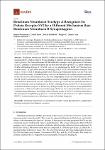Botulinum Neurotoxin Serotype A Recognizes Its Protein Receptor SV2 by a Different Mechanism than Botulinum Neurotoxin B Synaptotagmin
Weisemann, Jasmin
Stern, Daniel
Mahrhold, Stefan
Dorner, Brigitte
Rummel, Andreas
Botulinum neurotoxins (BoNTs) exhibit extraordinary potency due to their exquisite neurospecificity, which is achieved by dual binding to complex polysialo-gangliosides and synaptic vesicle proteins. The luminal domain 4 (LD4) of the three synaptic vesicle glycoprotein 2 isoforms, SV2A‐C, identified as protein receptors for the most relevant serotype BoNT/A, binds within the 50 kDa cell binding domain HC of BoNT/A. Here, we deciphered the BoNT/A‐SV2 interactions in more detail. In pull down assays, the binding of HCA to SV2-LD4 isoforms decreases from SV2C >> SV2A > SV2B. A binding constant of 200 nM was determined for BoNT/A to rat SV2C-LD4 in GST pull down assay. A similar binding constant was determined by surface plasmon resonance for HCA to rat SV2C and to human SV2C, the latter being slightly lower due to the substitution L563F in LD4. At pH 5, as measured in acidic synaptic vesicles, the binding constant of HCA to hSV2C is increased more than 10-fold. Circular dichroism spectroscopy reveals that the quadrilateral helix of SV2C-LD4 already exists in solution prior to BoNT/A binding. Hence, the BoNT/A‐SV2C interaction is of different nature compared to BoNT/B‐Syt-II. In particular, the preexistence of the quadrilateral β-sheet helix of SV2 and its pH-dependent binding to BoNT/A via backbone–backbone interactions constitute major differences. Knowledge of the molecular details of BoNT/A‐SV2 interactions drives the development of high affinity peptides to counteract BoNT/A intoxications or to capture functional BoNT/A variants in innovative detection systems for botulism diagnostic.
Dateien zu dieser Publikation
Keine Lizenzangabe

